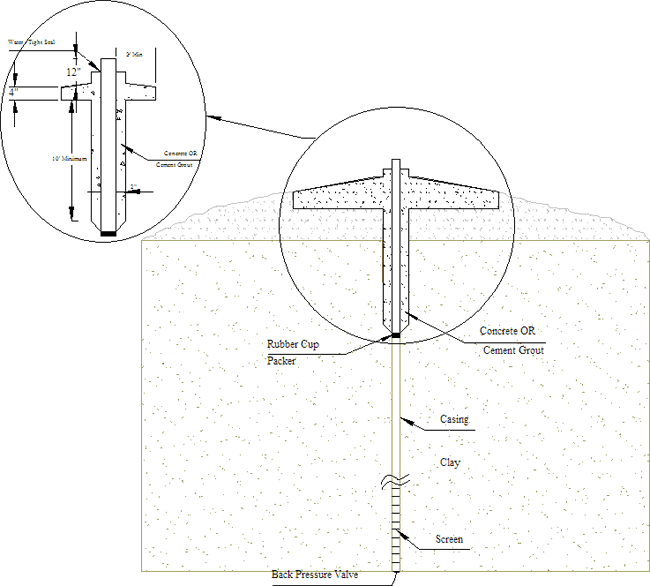About Private Wells
Health officials recommend the following disinfection procedure be used to properly disinfect private water wells that have become contaminated by microbiological organisms. Utmost care should be taken in conducting this procedure due to the high concentration of chlorine that is used. If this procedure does not eliminate the microbiological contamination after two attempts, a licensed water well contractor should be contacted for assistance in disinfecting the private water well.
Disinfection procedure
Step 1: Determine disinfectant
Step 2: Prepare the Solution
- If you use calcium hypochlorite - Dissolve 2 ounces (approximately 4 heaping tablespoons) of dry chemical in 2 quarts of water. The solution should be mixed vigorously for 10 to 15 minutes and then allowed to stand until all the inert material settles to the bottom. The clear liquid should then be poured into a 5 gallon container and the container filled with water. The inert material should be discarded. This will provide 5 gallons of chlorinated water to be used in the disinfection of the well.
If you use sodium hypochlorite (unscented household bleach) - Place 4 cups (1 quart) of the bleach in a total of 5 gallons of water. This will also provide 5 gallons of chlorinated water to be used in the disinfection of the well.
DO NOT drink this solution. It will have a high concentration of chlorine that is not safe to drink.
Step 3: Disinfecting well
Pour the 5 gallons of chosen solution down the well through the vent or cap (see illustration below). The pump should be pulled if possible to prevent any damage to the pump. Also, the solution should be poured through a garden hose that has been run down into the well. The garden hose should be pulled up and down as the solution drains into the well.
The 5 gallons of solution should be followed by an additional 10 gallons of water disinfected with ½ tablespoon of calcium hypochlorite or ½ cup of sodium hypochlorite. Note: If the well pump was not pulled, the pump should be started and pumped until there is a definite chlorine odor from the water.
If the pump was pulled, every part of the pump should be disinfected with a mild chlorine solution (at least 100 mg/l) prior to placing the pump back in the well.
The chlorinated water should then be allowed to stand in the well for at least 8 hours and preferably 24 hours if possible.
Step 4: Pumping
The well should then be pumped until no chlorine is present in the water.
Step 5: Collecting and sampling
A bacteriological sample should be taken and sent to the Mississippi Department of Health for analysis. The homeowner should contact the MSDH Division of On-site Wastewater for assistance with collection of a bacteriological sample. Samples may be dropped off at a county health department the same day they are collected for overnight shipment to the Public Health Laboratory. It normally takes approximately 24 hours for the Public Health Laboratory to analyze a bacteriological sample once it reaches the laboratory. For quicker results, samples may be delivered to the Public Health Laboratory in Jackson provided they are delivered to the laboratory within 28 hours of sample collection. The laboratory will accept samples between the hours of 8:00 am and 4:00 pm Monday through Thursday and between 8:00 am and 2:00 pm on Friday.
Step 6: Results
If the bacteriological sample is free of coliform bacteria, the private well can be considered to be properly disinfected and free of microbiological contamination.
If the bacteriological sample is not free of coliform bacteria, the disinfection procedure should be repeated.


